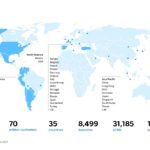Results: BBVA earns €1.2 billion in first quarter (+69%)
- Income: Recurring revenues and NTI results drove gross income up by double-digit y-o-y rates (+10.3%, +15% in constant terms). This, combined with cost containment efforts, helped to further improve the efficiency ratio below 50%
-Risks: The Group’s NPL ratio stood at 4.8% at the end of the quarter, compared to 4.9% in December; coverage increased slightly to 71%
-Capital: BBVA achieved a fully-loaded CET1 ratio of 11.01%, in line with the goal for 2017, gaining 11 basis points in the quarter
-Transformation: As of the end of March, BBVA’s digital customer base came to 19.3 million (+20% y-o-y). Of these, 13.5 million were mobile customers (+41%)

BBVA Group obtained a net attributable profit of €1.2 billion between January and March 2017, up 69% compared to the same period a year earlier (+79.2% in constant terms) and the highest of the past seven quarters. Net attributable profit grew across all business areas in y-o-y terms. The solid performance of income, moderation in operating expenses and a drop in impairment losses on financial assets are the main factors that underpinned this growth.
BBVA CEO Carlos Torres Vila said that “results for the January-March period show growth in all business areas, confirming BBVA’s ability to generate recurring revenues in any environment.” Other contributing factors he noted were “lower impairment losses on financial assets and cost containment efforts.”
Recurring revenues (net interest income plus fees and commissions) evolved very positively between January and March. Net interest income grew in line with the upward trend, reaching €4.32 billion, up 4.1% from the same period of the previous year (+9.2 at constant exchange rates). Fees and commissions were favored by the recovery of activity in wholesale businesses. This item grew 5.4% y-o-y (up 9.4% stripping out the currency impact) to €1.22 billion.
Gross income stood at €6.38 billion, up 10.3% from the first quarter of the previous year (+15% excluding currency impact). Growth in this line was driven by both traditional sources of banking revenue and net trading income strength. Capital gains on the sale of the 1.7% stake of Chinese bank CNCB (€204 million before taxes) were also recorded under this item.
During the first quarter, the impact of cost containment efforts became evident. The successful implementation of efficiency plans, along with the materialization of certain synergies, is already bearing fruit. All this resulted in a 1.2% drop in operating expenses in annual terms (+1.8% at constant exchange rates) and an improvement in the efficiency ratio, which closed under the 50% threshold (49.1%). This is significantly better than the average ratio of European peers (68.2% at the end of December). Therefore, the trends in income and expenses generated ‘positive jaws’, a graphic expression of this trend.
In this context, operating income reached €3.25 billion, with a growth of 24.2% compared to the previous year (+31.5% excluding the currency effect).
On the other hand, the positive performance of risk indicators continued. The NPL ratio maintained the downward trend begun in September 2015 and closed the quarter at 4.8%, compared to 4.9% in December. The coverage ratio improved slightly to 71%, while the cost of risk through March was 0.9%.
In terms of solvency, BBVA improved its fully-loaded CET1 ratio by 11 basis points in the quarter, to 11.01% in line with its goal for 2017 (11%). The fully-loaded leverage ratio stood at 6.6% in March. Regarding liquidity, BBVA Group’s LCR remained above 100% across all the regions in which it operates.
In terms of activity, gross lending to customers increased slightly (+0.3%) as of March 31, compared to last December, as a result of lending volume growth in emerging markets. In Spain, the trend remained the same as in previous periods: de-leveraging, despite the good behavior of new production, which posted y-o-y growth of 13.6% in businesses and 30.7% in consumer lending. As of the end of March, this item stood at €431.9 billion. Customer deposits decreased slightly in the quarter (-0.7%), driven by the decline in repos and other deposits and, to a lesser extent, time deposits. The balance as of March 31 stood at €398.5 billion.
The bank’s transformation
This first quarter showed once again how far BBVA has progressed in its transformation, with a focus on helping customers. At the end of March, BBVA had 19.3 million digital customers (20% more than in March 2016). Of these, 13.5 million were mobile customers, a 41% y-o-y increase.
One of the bank’s goals is to boost digital sales across all franchises. In Spain, the percentage of transactions conducted through digital channels was 24% in Q1-17, compared to 2016 average of 17.1%. In Turkey, the market where digitization has the biggest impact, the percentage went from 25.2% in 2016 to 30.1% in the first three months of 2017. Digital sales also gained momentum across all regions. In the year through March, in the U.S. these sales represented 21.7%, in South America, 22.3%, and in Mexico, 13.6%.
The key developments in each business area are detailed below.
Once again, Banking Activity in Spain showed its resilience in an environment with interest rates at all-time lows. From January through March, net interest income decreased 2.4% year-on-year, despite the positive results yielded by price management efforts and the improvement in customer spread. The decline was the result of lower loan volumes and sales of wholesale portfolios (with a positive impact on NTI). On the other hand, the positive contribution of wholesale businesses underpinned the recovery in fees and commissions (+8.6% vs. the fourth quarter). The quarter also saw a good performance of NTI, which grew 28.4% compared to the previous quarter. Operating expenses declined by 4% y-o-y.
For yet another quarter, impairment losses on financial assets dropped significantly (-36% y-o-y). However, €148 million were added to provisions, corresponding to restructuring costs aimed at further improving efficiency. Credit quality indicators remained stable in the quarter. The NPL ratio stood at 5.8% and coverage at 53%. Net attributable profit reached €375 million, a 54.2% increase compared to the first quarter of the previous year.
The Non-Core Real Estate area reduced its net exposure in the last three months by 9%, reaching €9.29 billion, thanks essentially to recent wholesale transactions. BBVA Group’s strategy is aimed at accelerating sales and reducing stock, capitalizing on the recovery of the real estate market. This business area posted a cumulative result through March of €-109 million.
To better explain the business trends in the areas that use a currency other than the euro, the variation rates described below refer to constant exchange rates.
In the United States the focus on price management and the interest rates increases drove net interest income up (8.2% y-o-y). The performance of fees and commissions was also positive (+15.5% y-o-y). All of the above, together with a good evolution of costs (-0.9% y-o-y) propelled operating income by 20.8% y-o-y. Also, credit quality performed favorably. The NPL ratio stood at 1.3% in March, with coverage ratio improving to 107%. The area’s net attributable profit was €134 million, up 163% compared with the first quarter of 2016, when energy portfolios were impacted by the drop in oil prices.
In Mexico, better macroeconomic perspectives had a positive impact on the currency. Activity continued its good performance despite some moderation during the period. In recurring revenues, net interest income grew by 8.4% y-o-y and net fees and commissions rose 12%. Cost containment efforts kept expense growth well under the increase in gross income, and operating income rose 16.9% y-o-y. Regarding asset quality, the main risk indicators remained stable. The NPL and coverage ratios closed in March at 2.3% and 128%, respectively. Mexico’s result in the first quarter reached at €536 million, with double-digit y-o-y growth rates (+19.2%).
Regarding Turkey, it is worth noting that BBVA in March closed the acquisition of an additional 9.95% in Garanti, increasing its stake at the Turkish bank to 49.85%. The area saw very solid activity, and together with price management strategy, net interest income rose 27% y-o-y. Fees and commissions, on the other hand, grew 14.6%. Both items were the catalysts that drove gross income growth (+21.3% y-o-y). All of the above and a moderate growth in expenses helped operating income to grow by 28.7%. Asset quality also behaved positively in a complex environment. The NPL ratio fell to 2.6% in March (compared to 2.7% in December) and remained below the sector’s average. Turkey’s quarterly net attributable profit jumped 45.7% y-o-y to €160 million.
In South America activity continued growing, both in terms of lending and customer funds. Net interest income grew 8.3% y-o-y, while fees and commissions rose by 20.5%. The good behavior of both items explains the growth in gross income during the quarter (+7% y-o-y). Expenses grew 11% y-o-y, below inflation rates in all countries except Argentina, which allowed operating income to increase by 3.5%, compared to the same period of the previous year. Regarding asset quality, the NPL ratio ended at 3.3% and coverage closed at 96%. The area earned €185 million between January and March, down 8.7% from the same period of 2016.
About BBVA

BBVA is a customer-centric global financial services group founded in 1857. The Group is the largest financial institution in Spain and Mexico and it has leading franchises in South America and the Sunbelt Region of the United States; and it is also the leading shareholder in Garanti, Turkey’s biggest bank for market capitalization. Its diversified business is focused on high-growth markets and it relies on technology as a key sustainable competitive advantage. Corporate responsibility is at the core of its business model. BBVA fosters financial education and inclusion, and supports scientific research and culture. It operates with the highest integrity, a long-term vision and applies the best practices.